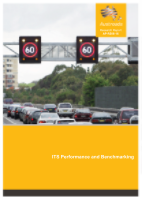Traffic Management

- Publication no: AP-R506-16
- ISBN: 978-1-925294-96-5
- Published: 28 January 2016
- PDF (free) Download
This report presents a consistent methodology to evaluate and report ITS asset performance from the road user perspective.
It reviews current ITS performance evaluation practices amongst Austroads and road agencies. VicRoads methodology was adopted and generalised, and a five-step framework was established to retrieve, analyse and report on asset performance.
User availability estimated from major alarms was used as the key performance indicator. Asset alarm data from SCATS signals, motorway electronic variable speed limit (EVSL) signs, and school zone electronic speed limit signs (ESLS) were collected from various Austroads jurisdictions to demonstrate the processes of the methodology.
The methodology could form the basis of a national process for Austroads jurisdictions to collect, analyse and report the performance of critical ITS assets consistently across all jurisdictions.
- Summary
- 1. Introduction
- 2. Background
- 2.1. Delivery Method
- 2.2. Review of Current Practice
- 2.3. Project Scope
- 3. Methodology of its Performance Evaluation
- 3.1. Step 1: Data Collection
- 3.1.1. SCATS Signals
- 3.1.2. Motorway EVSL and School Zone ESLS
- 3.2. Step 2: Estimation of Asset Availability
- 3.2.1. SCATS Signals
- 3.2.2. Motorways EVSL
- 3.2.3. School Zone ESLS
- 3.3. Step 3: Estimation of Impact on the Community during Asset Failure
- 3.3.1. SCATS Signals
- 3.3.2. Motorway EVSL
- 3.3.3. School Zone ESLS
- 3.4. Step 4: Reporting Availability Following Data Reporting Guidelines
- 3.4.1. SCATS Signals
- 3.4.2. Motorway EVSL
- 3.4.3. School Zone ESLS
- 3.5. Step 5: Benchmark Identification
- 4. SCATS Signal Performance Evaluation and Benchmark
- 4.1. Data Collection
- 4.2. Austroads/ARRB SCATS Availability Tool
- 4.3. Example of SCATS Signal Performance Reports
- 4.3.1. Availability Report 1: Monthly Availability for Selected Alarms
- 4.3.2. Availability Report 2: Monthly Availability against Level-of-service (LOS) for Selected Alarms
- 4.3.3. Availability Report 3: Monthly Availability against Top Nine Controller Makes
- 4.3.4. Availability Report 4: Monthly Availability against Geographic Regions
- 4.3.5. Availability Report 5: Worst Ten Sites for Selected Alarms
- 4.3.6. Availability Report 6: Impact on Communities during Signal Failure
- 4.4. Performance Benchmark
- 4.4.1. Benchmark for Availability
- 4.4.2. Benchmark for Availability against LOS
- 4.5. Impact on Community Due to Performance Change
- 4.5.1. Total Impact on Community during Signal Failure
- 4.5.2. Impact of Performance Change
- 4.6. Observation of Data Quality and Limitations of Reported Results
- 5. Motorway EVSL Performance Evaluation and Benchmark
- 5.1. Data Collection and Investigation
- 5.2. Examples of Victorian Motorway EVSL Performance Reports
- 5.2.1. Availability Report 1: Monthly Availability
- 5.2.2. Availability Report 2: Monthly Availability against LOS
- 5.2.3. Availability Report 3: Worst Ten Sites
- 5.3. Examples of QLD Motorway EVSL Performance Reports
- 5.3.1. Availability Report 1: Monthly Availability
- 5.3.2. Availability Report 2: Monthly Availability against LOS
- 5.3.3. Availability Report 3: Worst Ten Sites
- 5.4. Performance Benchmark
- 5.4.1. Benchmarks for Availability
- 5.4.2. Benchmarks for Availability against LOS
- 6. School Zone ESLS Performance Evaluation
- 6.1. Data Collection and Investigation
- 6.2. Example of VicRoads School Zones ESLS Performance Reports
- 6.2.1. Availability Report 1: Monthly Availability for Degraded and Failed Modes
- 6.2.2. Availability Report 2: Monthly Availability against LOS for Degraded and Failed Modes
- 6.2.3. Availability Report 3: Worst Ten Sites for Degraded and Failed Modes
- 6.3. Example of NSW School Zone Performance Evaluation Reports
- 6.3.1. Availability Report 1: Monthly Availability for Degraded and Failed Modes
- 6.3.2. Availability Report 2: Monthly Availability against LOS for Degraded and Failed
- 6.3.3. Availability Report 3: Worst Ten Sites for Degraded and Failed Modes
- 6.4. Discussion on Performance Benchmarks
- 7. Discussion
- 7.1. Limitations of the Research
- 7.2. Proposed Next Steps
- 8. Summary of Main Findings
- 9. Recommendations
- References
- Appendix A Review of Current Practice
- A.1 VicRoads ITS Performance Monitoring Report
- A.2 RMS Analysis of Traffic Signal Alarms
- A.3 RMS and Austroads Research on Reliability-centred Maintenance (RCM)
- A.4 Austroads AT1534 Management of Road Assets (including Electrical and Electronics)
- A.5 Other Relevant Projects
- A.5.1 Roads ACT Strategic Asset Management Plan (SAMP)
- A.5.2 Austroads ITS Product Acceptance Techniques for Network Devices
- A.5.3 Austroads ITS Procurement Best Practice Guidelines and Case Studies
- A.6 Summary of KPIs for ITS Asset Evaluation
- Appendix B VicRoads Method of Estimating Unit Delay Cost for Scats Alarms
- Appendix C Motorway EVSL Data Investigation
- C.1 Data Collection
- C.2 Observation of Data Consistency, Gaps and Limitations – VIC, QLD and TAS
- C.2.1 VicRoads and TMR– STREAMS BI Reports
- C.2.2 Department of State Growth (DSG) (TAS)
- Appendix D School Zone ESLS Data Investigation
- D.1 Data Collection
- D.2 Observation of Data Consistency, Gaps and Limitations – VIC, NSW and WA
- D.2.1 VicRoads
- D.2.2 RMS
- D.2.3 MRWA
